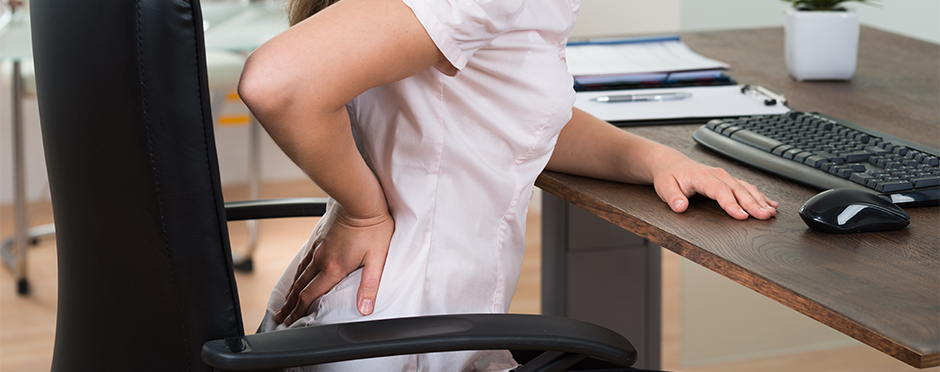
10 Side Effects of Prolonged Sitting
Leave a CommentOur children do it at school, many of us do it at work, most of us do it while commuting, and too many of us also do it recreationally. What is that magic “it?” If you guessed sitting then you hit the nail on the head.
A 2008 study by Vanderbilt University revealed that on average, most people sit 7.7 hours per day.1 Unfortunately, all of this time sitting comes at a price. Below are 10 side effects prolonged sitting has on your health and well-being.
- Altered posture and alignment: Gravity and fatigue tend to take over when you sit for too long, leading to a forward head, rounded shoulder and even slumped back posture. The stress and strain that come with altered positioning can lead to a myriad of different issues, like neck/low back pain, shoulder spurs or impingement syndrome, trigger points, and even disc degeneration.
- Tight muscles: The altered posture mentioned above leads to the neck, hip and shoulder flexors contracting. Over time, this can cause stress, strain and muscle tension.
- Weakness: When areas are overstretched or go dormant for long periods of time, weakness ensues. Sitting can cause a lack of strength in the back (erector spinae), scapular stabilizers (middle trapezius, rhomboids, latissimus dorsi and lower trapezius), buttocks (gluteus medius, minimus and maximus), and core (rectus abdominis, obliques and transversus abdominis).
- Decreased cardiovascular health: When you are sedentary, the heart – just like any other muscle – is not being challenged or pumping blood as vigorously. This can affect endurance, metabolism, blood pressure, cholesterol levels and other cardiovascular health factors.
- Obesity risk increases: Inactivity from sitting lowers the metabolism and the body’s ability to metabolize fat. I-Min Lee, a professor of medicine at Harvard Medical School, notes that we burn 30 percent more calories standing than sitting.2 Cumulatively this can make a difference in your health in terms of weight control.
- Diabetes (type 2) risk increases: Researchers from the University of Missouri found that when one goes from high activity (10000 steps/day) to low activity (fewer than 5000 steps/day), insulin levels can be raised and enzyme activity decreased. This can contribute to a greater likelihood of developing type 2 diabetes.3
- Psychological stressors: According to an article from Psychology Today, sitting can increase depression, anxiety and lower mental well-being.4
- Altered digestion: Prolonged sitting after eating can compress the abdominal cavity thus slowing down digestion, which can lead to various issues like heartburn and constipation.
- Cancer risk increases: Though the direct cause is not fully understood, an article series from the British Medical Journal (BMJ) showed sitting increases the risk of lung cancer by 54 percent, uterine cancer by 66 percent and colon cancer by 30 percent.5
- Overall mortality: prolonged sitting increases the risk of all-cause mortality by 49 percent per research findings in a 2012 Diabetologia6
The long and short of it is that there can be consequences when we don’t live a healthy lifestyle that includes activity. Research even shows that people who vigorously exercise either before or after excessive sitting cannot undo many of the negative health factors.7 So where does that leave us? Some experts say you should start standing up at work for at least two hours a day, and work your way toward four. If excessive sitting is leaving you sore, you can also schedule an appointment for a free assessment at your nearest Athletico location.
Share some of your favorite ways to minimize sitting in the comments below and stay tuned for our follow up article addressing just that.
The Athletico blog is an educational resource written by Athletico employees. Athletico bloggers are licensed professionals who abide by the code of ethics outlined by their respective professional associations. The content published in blog posts represents the opinion of the individual author based on their expertise and experience. The content provided in this blog is for informational purposes only, does not constitute medical advice and should not be relied on for making personal health decisions.
1. Matthews, C. E., K. Y. Chen, P. S. Freedson, M. S. Buchowski, B. M. Beech, R. R. Pate, and R. P. Troiano. “Amount of Time Spent in Sedentary Behaviors in the United States, 2003-2004.”American Journal of Epidemiology 7 (2008): 875-81. Web.
2. Corliss, Julie. “Too Much Sitting Linked to Heart Disease, Diabetes, Premature Death.”Harvard Health Blog. N.p., 22 Jan. 2015. Web. 16 June 2017.
3. Mikus, Catherine R., Douglas J. Oberlin, Jessica L. Libla, Angelina M. Taylor, Frank W. Booth, and John P. Thyfault. “Lowering Physical Activity Impairs Glycemic Control in Healthy Volunteers.”Medicine & Science in Sports & Exercise 2 (2012): 225-31. Web.
4. Andrews, Linda Wasmer. “What Sitting Does to Your Psyche.”Psychology Today. Sussex Publishers, 20 Mar. 2014. Web. 16 June 2017.
5. Mayor, S. “Prolonged Sitting Increases Risk of Serious Illness and Death Regardless of Exercise, Study Finds.”Bmj Jan19 7 (2015): n. pag. Web.
6. Wilmot, E. G., C. L. Edwardson, F. A. Achana, M. J. Davies, T. Gorely, L. J. Gray, K. Khunti, T. Yates, and S. J. H. Biddle. “Sedentary Time in Adults and the Association with Diabetes, Cardiovascular Disease and Death: Systematic Review and Meta-analysis.”Diabetologia11 (2012): 2895-905. Web.
7. Hamblin, James. “The Futility of the Workout-Sit Cycle.”The Atlantic. Atlantic Media Company, 16 Aug. 2016. Web. 16 June 2017.
8. Schulte, Brigid. “Health Experts Have Figured out How Much Time You Should Sit Each Day.”The Washington Post. WP Company, 02 June 2015. Web. 16 June 2017.
